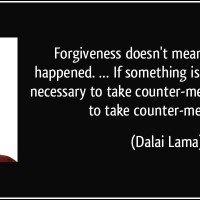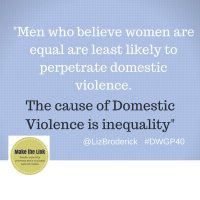
by Laurent Fintoni via flickr
Kate Ellis, Minister for the Status of Women, launched a 12-year national plan last month that is designed to reduce violence against women and children.
The plan is based on research that indicates as many as one in three Australian women will experience physical, sexual and emotional abuse by men during their lifetimes.
The plan expresses the intention to address social norms and practices, rigid beliefs about gender role expectations and cultural values, all of which contribute to a society in which violence against women and children is endemic. Currently, there are more reported assaults on women by men.
However, what the plan completely neglects to address is that there is also a great deal of anecdotal evidence that women are the primary perpetrators of the emotional abuse of children, with disastrous and long-lasting effects.
Any 12-year national plan to prevent violence against children should include proper and full investigation into this type of child abuse. Why doesn’t this one?
Paucity of empirical research
While there are studies on female violence against male partners, it’s difficult to find current research on the occurrence and effects of maternal emotional abuse on children, and on the adults they become. Research has lagged behind clinical experience, notes the author of this 2007 study and there is a relative paucity of empirical data.
Yet there is a plethora of anecdotal evidence to be found on the long-term effects of maternal emotional abuse on the development of children, and on their adult lives.
There are thousands of personal stories of emotional abuse – maternal bullying, attacks on the young child’s self esteem, the long-term consequences of being raised by a narcissistic mother for whom one is little more than an accessory in public, and an emotional whipping post in private. This clinical term has been colloquially adopted as shorthand for maternal emotional abuse.
There are 10 Google pages dedicated to the term, and a further 10 pages dedicated to maternal emotional abuse. The term “narcissistic mothers” sits comfortably with increased societal concerns about the “sexualisation” of young children, specifically when young girls are dressed and made up as if they were adult women.
Campaigners such as the Australian Christian Lobby and Melinda Tankard Reist express profound and I believe legitimate concerns about this increasing practise.
However, the elephant in the room is that mothers and female caregivers overwhelmingly purchase and dress young girls in this manner. Reist, the ACL, and many other campaigners apparently find it easier to lay all blame at the door of various media and advertising outlets.
They neglect to mention the responsibility mothers and female caregivers must bear for purchasing these products, and choosing to dress their little girls like adult women. It’s reasonable to investigate the possibility that such mothers and caregivers are indeed abusively acting out their own narcissistic and unrealised desires through their little girls.
The stories of maternal abuse are out there
The long-term consequences of maternal abuse
Maternal abuse is a broad predictor of adult dysfunction in the areas of relatedness, identity, affect regulation, abandonment concerns, and borderline and anti-social features. Briere and Rickards found that “high paternal support did not appear to reduce the negative effects of maternal abuse”.
On the matter of childhood sexual abuse the authors note: For example, the current results suggest that childhood sexual abuse, although significantly related to impaired self-capacities, is second to the effects of childhood maternal abuse. (emphasis mine.) Such data does not mean that sexual abuse is less than psychologically toxic, but rather that another form of child maltreatment—one less addressed in the literature—may be even more traumagenic. Additional study is clearly indicated to determine the reasons (whether biological, attachment-related, or sociocultural) for this specific effect.
The area is almost a professional and wider societal no-go zone – so thoroughly has feminism succeeded in creating the belief that the perpetration of intra-familial abuse is a primarily male phenomenon. Yet there are many, many women and men who experientially know this is not so. Why don’t feminists who are in a position to do so, validate this experiential knowledge, and clamour for empirical research?
W Kierski addresses professional reluctance in his paper ‘Female violence: can we therapists face up to it?” This link appears to come and go, but Google “female violence” and you’ll find this paper, and 11 further pages with both scholarly and anecdotal material on the topic.
The reality many feminists resist
Together with society’s reluctance to consider that mothers are anything but good, as well as the difficulties of identifying what can seem, compared to physical injuries, a nebulous concept of emotional maltreatment, this area of abuse receives far less attention than others. It is described by some mental health professionals as the “hidden” form of maltreatment.
Unpopular as this notion might be, it’s my opinion that feminism has created a simplistic but powerful binary narrative in which men are perpetrators and women are victims. This has now hardened into a rigid gender role expectation.
There is very little room in this story for the reality of female violence against male partners, against other women, and against children, unless a woman murders them or otherwise physically abuses them in a manner worthy of media attention. These women are then cast in the role of the extremely bad mother, and frequently subjected to vitriolic public attacks.
Yet victims can also be perpetrators, regardless of their gender. This is the reality many feminists resist, to the detriment of all of us, and in particular, our children. The halcyon days of brilliant feminist scholarship and subsequent ground breaking cultural change are over. The once inspirational ideology has degenerated into little more than housework and lipstick cat fights.
The first feminist clique to address the issue of maternal emotional abuse, and lobby for urgent and comprehensive research into its occurrences and effects, will receive my support. Feminists have always led the way in addressing domestic violence perpetrated by men – now it’s time for women to address intimate partner violence and child abuse by women.
This is not something women would accept being addressed by men. It can only be seriously addressed by women ourselves.
What we know so far is that there is very good reason to investigate. If further study bears out the 2007 Briere and Rickards’ data, we are looking at a profoundly significant determiner of adult well being, one at least equal in its probabilities of long-term damage to male perpetrated domestic violence, and the sexual assault of children.
Facing up to and addressing maternal emotional abuse is quite possibly feminism’s next frontier, and if the sisters baulk at it and stay with the trivia, then what is feminism really good for in 2011?
WHAT THE NATIONAL PLAN SAYS
The definition of domestic violence used in the new 12 year National Plan announced by Minister for the Status of Women, Kate Ellis, last month, does not acknowledge any familial abuse other than that perpetrated by men:
Domestic violence refers to acts of violence that occur between people who have, or have had, an intimate relationship. While there is no single definition, the central element of domestic violence is an ongoing pattern of behaviour aimed at controlling a partner through fear, for example by using behaviour which is violent and threatening. In most cases, the violent behaviour is part of a range of tactics to exercise power and control over women and their children, and can be both criminal and non-criminal.
Read: “in most cases the central element of domestic violence is violent male behaviour” towards women and “their children.”
Female violence against intimate male partners, well researched for quite some years now, and alleged by some researchers to be as common as male violence, and often differently expressed, is inexplicably omitted.
Maternal violence of any kind against children is omitted, though paternal or male violent behaviours against “women’s” children are included in the definition.
Further in the document we find this:
It [the Plan] will look at building positive attitudes and beliefs, social norms and ways for organisations to confront controlling, macho, aggressive and ultimately violent behaviour.
Read: “Violent male behaviour, because with “macho” in there, what else could it be?
The vision of the National Plan is that: ‘Australian women and their children live free from violence in safe communities.’
Read: “free from male violence” as female violence is not acknowledged in the definition.
And then: Values and Principles are: Responses to children exposed to violence prioritise the safety and long term well-being of children.
Read: “Responses to children exposed to male violence’, as female violence is not acknowledged in the definition.
And then: Protecting Children: Physical abuse, emotional maltreatment, neglect, sexual abuse and witnessing family violence are now all recognised as forms of child abuse and neglect. In April 2009, COAG endorsed Protecting Children is Everyone’s Business—National Framework for Protecting Australia’s Children 2009–2020. This framework is aimed at reducing child abuse and neglect in Australia over time. The National Plan and the National Framework are designed to work in tandem to bring about positive change for women and children experiencing violence.
Read “ experiencing male violence.”
The linking of the two plans suggests the National Framework might also be based on an interpretation of domestic violence as male violence. I haven’t checked. I hope I’m wrong.
And: The primary objective of perpetrator interventions is to ensure the safety of women and their children.
Read: “Male perpetrator interventions”
The examples are numerous. See:
http://www.fahcsia.gov.au/sa/women/progserv/violence/nationalplan/Pages/default.aspx
We need a plan that addresses violence perpetrated on children by both women and men that includes physical abuse, emotional maltreatment, neglect, sexual abuse and witnessing family violence.
We need research into maternal emotional abuse of children. We need research into female intimate violence. We need a plan that acknowledges the realities of domestic violence, not one based entirely on out-dated stereotypes of gendered violence.
After forty years of treating domestic violence as a male only phenomenon, there has been no significant decrease in violence and child abuse statistics. This indicates that there is something we are not investigating, and female violence against intimate partners and children is very likely it.







































Not everyone has the”wherewithall” for parenthood, same as not everyone is kitted out to win Wimbledon.
Plenty of blokes are left footed with it and i t seems at least some women, too. But not every person who lacks the aptitude for it necessarily deserves approbation.With women alone, there are various forms of depression and other stress related responses; after all the physical inputs alone, carrying then caring, must be phenomenal.
If this is about maintaining a good and improving support system for families, I’d say great.
Then it stays at the level of solving problems rather than apportioning blame.
LikeLike
The problem with the National Plan is that it does blame – instead of including female violence in the definition, it focuses only on male, totally unrealistic, so there’s no hope of researching the dynamics of the problem – just carrying on as usual with no change in sight.
Dumb as….terrrible waste of money…no help for adults and children except bandaids when somebody gets hurt Not happy, Julia and Kate. Very not happy.
LikeLike
Regrettably, these feminist reality distortions are very common in modern Western world. Every voice speaking out against them is a valuable contribution.
You did overlook one crucial issue in your analysis:
“In most cases, the violent behaviour is part of a range of tactics to exercise power and control over women and their children, and can be both criminal and non-criminal.”
Here there is an additional feminist norm of interpretation in the “power and control”. While this may often be the case, most cases are likely to go back to other reasons, including the results of drug consumption, heat-of-the-moment events, and a stressful living situation. By inserting the “power and control” part, the issue is moved from abusive-men-who-are-victims-of-circumstances to abusive-men-who-are-evil-patriarchical-bastards (after already having misfocused on men-as-perpetrators and discounting mutual and women-against-men violence).
LikeLike
That last sentence is spot on. The whole tone of the document is built on men as evil patriarchal bastards, simplistic reductionism that will achieve nothing for anyone, and it hasn’t.
We’ve become much better at dealing with some of the consequences of DV, refuges, laws, heightened awareness etc. But as far as addressing the causes, we’ve achieved nothing in public policy.
LikeLike
“After forty years of treating domestic violence as a male only phenomenon, there has been no significant decrease in violence and child abuse statistics. This indicates that there is something we are not investigating, and female violence against intimate partners and children is very likely it.”
Very powerful punch to finish with. Excellent debating skills.
LikeLike
No, I’m not crossing the line to join with Michael Ericsson. The feminists still have a point and a major one shared, I think by Jennifer herself, that men as well as women, need to contemplate their own conditioning. In our society in the condition it is, ordinary people need not retreat into old and disproved certainties, nostalgia and the like but ensure the worst vices, revolving around insecurity and control freakery on all sides, are ameliorated, which is a hard thing to do as regards a situation when you are fully engaged in coping with and surviving it.
I’d hate t o see a continuance of the sort of marriage my parents had, or were trapped in, by obsolete conventions and beleifs at odds with changing times.
LikeLike
Dear Jennifer,
I am so angry at your article on maternal abuse that I am forced to let you know that your comments are tantamount to treason against women worldwide.
Why is it that everytime some inroad is made against the tirade of violence wrought against women by men does some “know all” start espousing about the terrible damage mothers cause their children. Whenever there is a serious crime why do we always look at the mother…?
Are you a mother?
I doubt it.
And why is it that a minority group i.e. narcissitic mothers, takes priority in your article, when the goverments plan is about reducing violence against women. The statistics speak of endemic male violence against women. Your forget to mention narcissistic fathers. Your omit to mention fathers abuse of their children by their sexual assault, by their neglect and by their physical and emotional absenteeism while they are ‘bonding’ with their mates. You forget to consider that this problem, of domestic violence against women and children, has been ingrained in our society since the stone age.
Do you realise the damage that an article like yours does to all the hard work and campaigning literally fought by women for decades in a stand against men and their fists? It justifies their violence, because you are telling the world that Women are ultimately to blame for their violence. Bad, bad mothers. Once again, you are casting the first stone against your peers. How very intelligent of you.
Why not research feminism, Jennifer Wilson?
Why not deconstruct patriachy?
Why not gain an understanding of domestic violence even, before you start espousing your opinions?
Try reading The Alphabet vs The Goddess, by Leonard Shlain and learn some herstory.
Shame on you Jennifer
Shame
Shame
Shame
LikeLike
I wrote the article because so many adult children and men report abuse by women who are their mothers and partners.
What good will it serve anyone to ignore this?
You sound like George Bush – you think I’m either with you or against you.
I want something to change – the feminist approach to domestic violence has not succeeded in reducing it one bit – all it’s done is get better at cleaning up after the event.
Don’t you want better than that for everyone?
LikeLike
There is no “tirade of violence wrought against women by men, nor does “ The statistics speak of endemic male violence against women”: By and large this a myth created by feminists and their allies, using falsified or misinterpreted statistics—or even entirely unsupported propaganda.
Notably, modern research on domestic violence shows that most cases are mutual, and that in the non-mutual cases women are more likely to be the perpetrators and men the victims. (The original post already contains the number one source for an overview on this, but to repeat it: http://www.csulb.edu/~mfiebert/assault.htm You may also want to read some of Erin Pizzey’s writings. )
Notably, rape statistics have regularly been distorted in an extreme manner, as e.g. with the alleged campus rape crisis. See e.g. http://michaeleriksson.wordpress.com/2010/12/10/rape-statistics/ for more information.
There is violence from men against women, but the scope is far smaller than feminists claim and we should focus on the real problem: Violence. (Including women’s violence against men, men’s violence against men, and women’s violence against women.)
LikeLike
Er…. I think the comment by “Rose” is meant to be parody.
LikeLike
Someone called Rose posted in the same vein on the Drum – but after your comment Steve, I’m wondering the same!
LikeLike
Yes, I must admit I find that am not really further advanced in understanding the issues, for Michael Erikkson’s and Roses posts- both are in denial on aspects of their positions and need to step back, take a breath and think a bit more carefully on their respective propositions.
Michael, of course there is violence against women, kids and other blokes, right across the world- no one is accusing you of it so dont take it personally. And its the most common form.
But Rose, there is also a problem involving a percentage of women. Once again , dont take it personally, some women, like some men, come from poor backgrounds, lack “wherewithall” and so on, and there might be reasons others need to understand as to why and the problem here also may need to be solved. Solving one form o f violence does not preclude solving other, if smaller problems also create damage to numbers of victims.
LikeLike
I am not in denial of anything and my position is both well thought-through and based on extensive readings: I wrote my comment with the explicit and deliberate purpose of countering an ever-repeated lie that has distorted the debate for decades and fooled millions of people—often leading to those who truly are interested in e.g. equality to give their support to those who are not. Again: “There is violence from men against women, but the scope is far smaller than feminists claim and we should focus on the real problem: Violence.”
Have you bothered to actually read what the non-feminist statistics on rape and DV says? The numbers are radically different from what ideologically tainted sources tend to claim. Further, even the numbers aside, feminists regularly grossly misrepresent what is going on by trying to reframe violence to men’s-violence-against-women and violence-as-it-is to violence-as-a-systematic-and-deliberate-way-of-oppressing-women.
LikeLike
Back for a second read and in mind of the minister, who is also my local member and who I met v briefly a couple of days ago a local park, where her and local mps were doing meet and greet, as part of their efforts to “sell” major real estate development and TODS, including changes which could be seen to represent an assault on local parks and amenities in order to finance increasingly high density housing.
At one stage a local mp commmented, with an eye on Elllis, invoking the mantra of higher density living as the price to pay for adequate housing for “working families” .
It came to me much more clearly how gender is a political footy and battle field for opposites philosophies and political forces, fought through symbolism and thetoric. The mp, in making his statement, directly put those of us dubious about erosion of commons and amenity aand fearful of the social consequences of poor housing, in direct conflict with uncounted numbers of young”working families”, we became bogies for thousands of heroinic young women out to do their duty for the baby bonus, mortgage rebates, “growth” and a conveniently invoked “national project” that on most other occasions must play second fiddle to neoliberal globalisation.
As Jennifer says at one stage, the nub of this problem of convenience comes in maintaining the adversarial terms under which both the politics and economics is underwritten- for reducing the complexity of social problems and the “social problem” to abstract caricatures of the mid twentieth century “bloke” as the source of all catastrophe merely reinforcing old stereo types that divide rather than allow citizens to collectively view and implement solutions to accurately perceived problems rather than their symptoms.
I fear that “rack and stack” and anti ntellectualism combined ensure the continuance rather than amelioration of life issues for increasingly economically and politically commodified people.
LikeLike
Thinking on it, it also has me thinking that Plibersek would be as much responsible for this area of policy as Ellis- had this been in Sydney Ill wager Plibersek would have represented it rather than Ellis, but Ellis is local and interchangeable in selling change (as) only possible within the constraints of a neolib paradigm.
LikeLike
After reading a confession by Svengali,on the blog about anonymity,I’m starting to see many IDs as being trolls theses days.
Mixed in with the lunatic fringe element of course.
Makes this whole blogging thing very tiresome.
I think Helvi’s take is correct.
Respond to the moderate posters.
Criticise the extremists directly through articles,but suffer them a fate worse than their deepest fears.
Sentence them to being ignored.
LikeLike